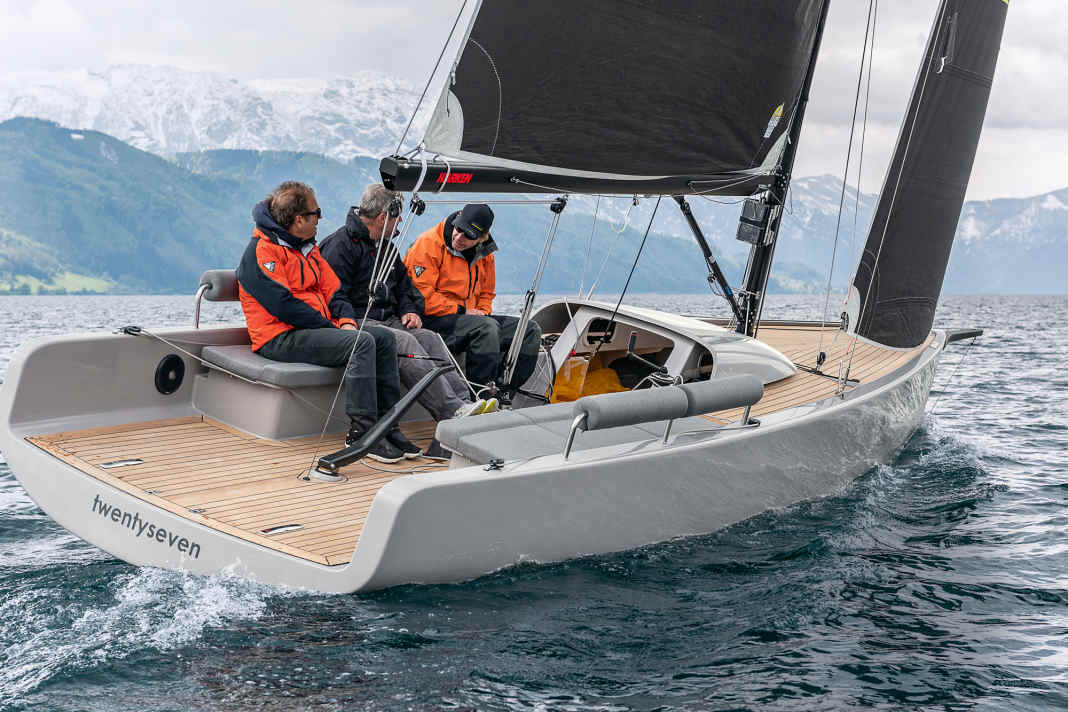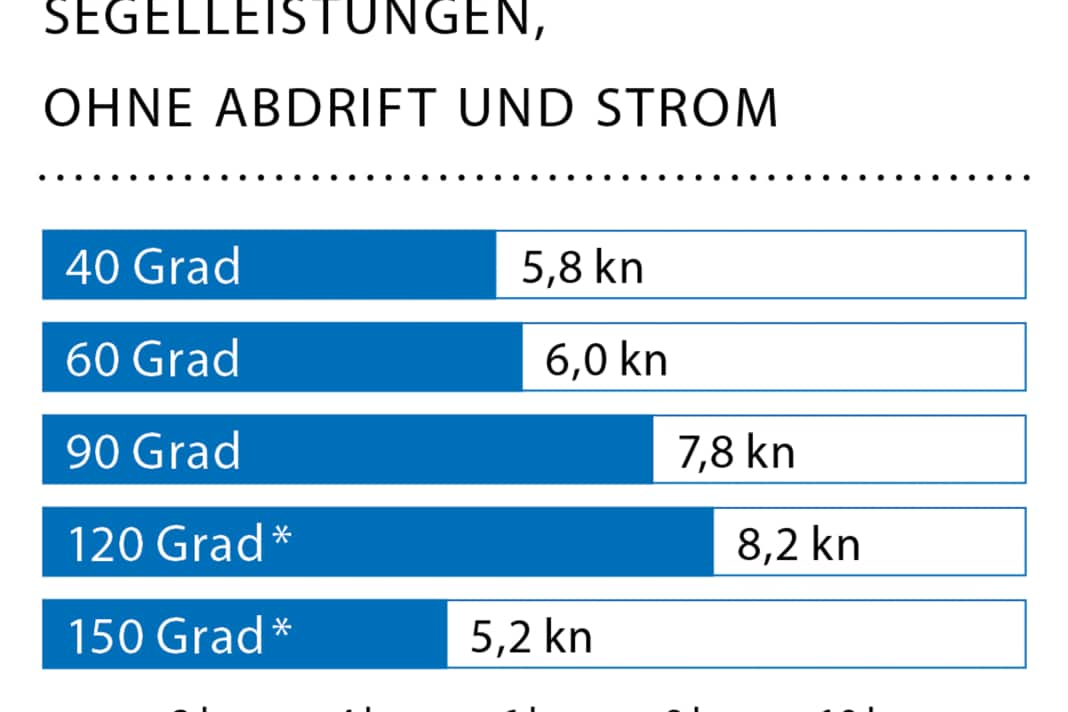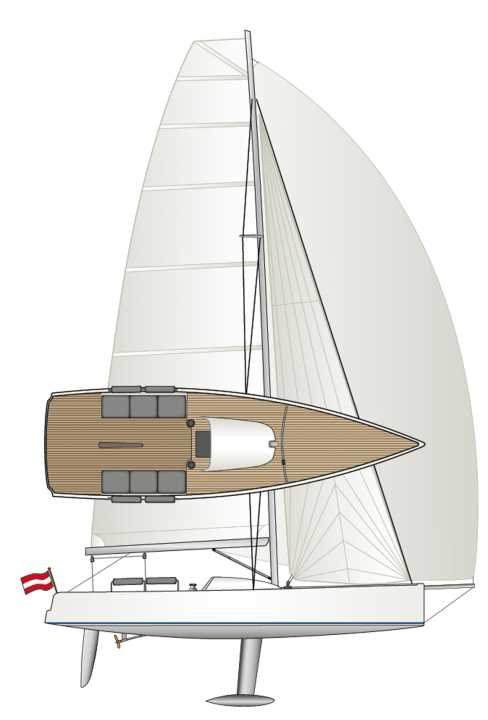





No, this is neither a spelling mistake nor a misunderstanding. The smart daysailer was presented to great acclaim as a world premiere under the name B27; now, however, the same boat is being offered as the A27. Behind the miraculous change from B to A lies a delicate and rather confusing story about an unpleasant dispute between Luca Brenta's family in Italy and Michael Gilhofer's company Yachtworks on Lake Attersee in Austria. The dispute centres on trademark and building rights as well as distribution claims within the conceptually homogeneous line of daysailers commonly known as Brenta - or B-Yachts.
At the time of the test, however, the dispute had been settled in court and the differences had been resolved. Gilhofer's shipyard in Austria is now trading as A-Yachts with two models of its own production, the A33 (formerly Brenta 33 ) and the new A27, which we present here in the test. Those who claim that an A27 has already existed before, namely from Archambault. However, the shipyard in France no longer exists, so the type designation is once again available - even if this should cause even more confusion.
Regardless of all this background, the design of the A27 also comes from Lorenzo Argento. The Italian is a former partner of Luca Brenta and has played a key role in shaping the series of renowned Brenta Daysailers.
The elegant and elongated lines, the unobstructed cockpit with upholstered thwarts and attachable backrests as well as the short, hood-like cabin superstructure are typical of his signature. The look and concept are still considered to be style-defining for an entire generation of modern daysailers and have been copied many times, for example by Alphena Yachts or Dinamica Yachts. However, they have never achieved any significant market presence.
Stiffer thanks to carbon
Michael Gilhofer has the A27 manufactured in Slovenia by Oceantec. There, the hull, deck and floor assembly are elaborately built using a vacuum infusion process with vinyl ester resins and a predominant proportion of carbon fibre. The deck is even made entirely of carbon fibre. The low weight of just 1.6 tonnes when ready to sail is merely a "welcome side effect", says designer Lorenzo Argento, who is on board for the YACHT test on Lake Attersee; for him, the stiffer structures are more important. Because the boat is slim with a width of 2.40 metres and the proportion of ballast in the T-keel is high at 50 percent, higher forces are transferred to the hull via the shrouds of the sporty rig. In addition, the mast is driven without a backstay, which requires more rig tension so that the forestay does not sag too much in the wind.
Compared to the B30 as the "original Brenta", the design of the A27 bears witness to the yacht's development over the years. Despite the generally slender frame, the shapes at the bow and stern have become fuller. Although the frame is not bent at the rear, it is still noticeably angled in order to achieve a flatter underwater hull and thus more volume for more buoyancy. Argento hopes that this will make the small daysailer stiffer and more upright, which is indeed the case in the test. The boat reacts to gusts with acceleration instead of heeling. It makes almost no difference whether the other sailors are upwind or downwind.
The A27 has prospects of success on the regatta course
With average winds of between 6 and 8 knots, the A27 crosses at a good 5.8 knots and tacks at a narrow angle of just 80 degrees. With the 65 square metre gennaker, the boat also demonstrates a pleasing sportiness. The smart daysailer quickly logs a speed of more than 8 knots, which roughly corresponds to the true wind speed. With these excellent performance data, the boat certainly qualifies as a powerful inland racer with prospects of success on the regatta course.
The A27 sails in a very balanced manner. At the cross she has a slight upwind tendency and gives the helmsman a noticeable rudder pressure, which is very pleasant, especially for a boat with a tiller. The crew doesn't have much to do when tacking, apart from switching from one side to the other. The self-tacking jib requires no active intervention during manoeuvres, nor does the mainsheet, which is guided centrally into the cockpit.
Ambitious sailors might want a traveller for trimming the mainsail, which is strongly flared at the top, but the shipyard does not want to offer this as an option. However, the boat comes with a powerful boom vang as standard, which can compensate for this function to a certain extent.
Nice and clean" is the motto for the A27
The A27 also follows a true minimalist principle in terms of trim options. The halyards as well as the trim and reefing lines run inside the superstructure back to the two winches on the side of the companionway, which can also be ordered with electric drives. The sheet cleats and halyard stoppers are elegantly built under the canopy, which is only attached; "nice and clean" is the motto. And yet: everything you need for sailing is there, well positioned and of exquisite quality in terms of equipment. Solo skippers, in particular, will find it easy to handle and operate all sheets and lines themselves thanks to the tiller steering.
The comparatively high aluminium mast from Lico Spars in Italy is through-stepped and stands on the floor assembly. Low-stretch rod shrouds are included as standard. An identically high carbon fibre rig (with main boom) from Southern Spars is available to customers as an option for an additional charge. As an alternative to the self-tacking jib, the shipyard can also realise an overlapping genoa with hole point rails on the running deck, but refrains from labelling this as an extra - "it simply doesn't fit in with the concept," says Michael Gilhofer.
Another standard feature is the 80 centimetre long bowsprit made of carbon fibre. This is guided in a recess at the bow and is only bolted on there. This makes it easy to remove the trunk for road transport, for example.
Only fixed fuselage attachments for the A27 for the time being
The keel is available in two versions, as a standard T-keel with a draught of 1.75 metres and alternatively in a slightly shorter version with a draught of 1.50 metres. In this case, the rig would also be slightly less high. However, the shipyard has not yet specified an option for flexible hull appendages, for example with a lifting keel and cassette rudder. However, the technical possibilities are being examined and A-Yachts could well respond favourably to enquiries. With a width of just 2.40 metres and a weight of just 1.6 tonnes, the A27 is still a suitable trailer boat, even without a lifting keel.
Below deck, the A27 is a pure daysailer: Inside, the ship remains yawningly empty for the time being. Fabric pockets are attached to the sides and act as flexible storage compartments to keep things organised. Otherwise, the bare, sober white of the immaculate surfaces dominates. Two long benches extend into the aft section and can be used as berths with a length of two metres. Cushions are available as an option. It is also possible to install an additional plywood bunk store in the completely empty foredeck. The shipyard apparently already has a ready-made plan for this. This means that the daysailer can be converted into a weekender for a small family with little effort.
Electric as standard
As standard, the A27 is fitted with an electric motor with shaft drive from the Austrian manufacturer Aquamot. The shipyard has opted for a fixed shaft so that the heavy mechanical parts and the Torqeedo battery pack can be installed as centrally as possible at the front of the boat. Under engine power, the boat achieves a speed of 5.5 knots when cruising in calm water with little wind.
Incidentally, the technical installations are generally very clean and clearly laid out, and accessibility is exemplary throughout.
With a base price of around 136,255 euros, the A27 daysailer, which is just eight metres long, is optimistically priced. You also have to pay extra for a proper sailing wardrobe with main, jib and gennaker. A lot of money for a fairly small boat - but one that packs a real punch.
The measured values for the A27 test



The A27 in detail

Technical data of the A27
- Design engineer:Lorenzo Argento
- CE design category:C
- Torso length:8,18 m
- Width:2,40 m
- Draught/alternative:1,75/1,50 m
- Weight:1,6 t
- Ballast/proportion:800 kg/50 %
- Mainsail:29,0 m2
- Self-tacking jib:15,0 m2
- Machine (electric):6.0 kW
Hull and deck construction
Sandwich construction with vinyl ester resin using the vacuum infusion process. Deck and parts of the hull made of carbon fibre
Price and shipyard
- Base price ex shipyard:136,255 € incl. 19% VAT, without sails
- Guarantee/against osmosis: 2/2 years
Prices as of 11/2023, as the prices shown are defined, can be found here !
Shipyard
A-Yachts/Yachtworks GmbH; 4864 Attersee (Austria); www.a-yachts.info
Distribution
Dealer network
YACHT rating of the A27
A skilful transfer of Brenta's tried-and-tested daysailer idea into a smaller format. The new name (A instead of B) can be confusing, but does not detract from the successful and well thought-out concept. Comparatively expensive
Design and concept
- + Uncompromising alignment
- + Strong construction with carbon fibre
- + Simple touring capability
- + Customised lines
- - No option for a lifting keel
- - High price
Sailing performance and trim
- + Balanced sailing characteristics
- + Very easy handling
- + Unrestricted single-handed use
- - No mainsheet traveller
Equipment and technology
- + High-quality basic equipment
- + Electric motor with shaft drive
This article first appeared in YACHT 18/2019 and has been updated for this online version.

